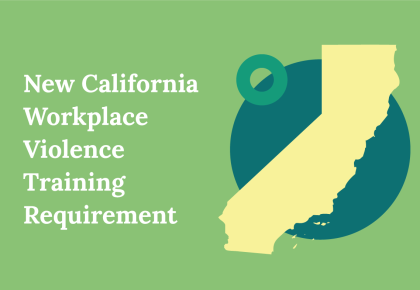California Workplace Violence: A Primer for Compliance with SB 553
Is your organization ready to meet these new training requirements?
California’s sweeping legislation on the prevention of workplace violence goes into effect on July 1, 2024. The law, which was proposed (and passed) last year as Senate Bill 553, amends California Labor Code sections 6401.7 and 6401.9 to add new requirements that apply to nearly every employer in the state. For more detailed information (including frequently asked questions) on the requirements of the law, please refer to Syntrio’s January 18, 2024, article entitled New California Workplace Violence Training Requirement Goes into Effect on July 1, 2024. Today’s article will prepare employers with the considerations necessary to formulate a workplace violence prevention (“Plan”) and get you primed to conduct the initial round of required training by July 1, 2024.
Complying with the new California law will take careful planning and time.
SB 553 is the most comprehensive workplace violence prevention legislation enacted in the United States to date. Before formulating and implementing the Plan, the law requires employers to consult a variety of different parties, perform an assessment of workplace violence hazards, and establish procedures for responding to violent incidents (and logging records of any such incidents). As always, Syntrio recommends consulting with legal counsel for advice on properly complying with the details, but we are here to provide you with the information necessary to ask the right questions when preparing for compliance.
Employers must involve employees in the planning process.
Unique to other workplace violence legislation, SB 553 requires employers to consult with employees in Plan development and the implementation process. This is a crucial step to take before July 1, as different sets of employees will have a variety of viewpoints on what is important to them (and their particular situations) concerning workplace violence. By consulting with a variety of managers and non-managers alike (as well as employees working in different environments and situations), you will be able to formulate a plan that is comprehensive to your workforce as a whole.
Multi-employer situations must consult with one another to coordinate their Plans.
In the modern work environment, there are situations where different businesses work closely with one another. Perhaps the best example that can be provided is the retail industry, where several businesses are often located near one another. By consulting with those employers in your community and general sphere, you will gain clarity about potentially dangerous situations common to the area or environment, and include them in all employer Plans.
Employers must determine specific risks to their work environment and include them in the Plan.
SB 553 is a detailed law. Part of the Plan requirements involve personalizing each plan to specific risks identified by the employer, the employees, and other businesses that may increase the risk of violence. While it is impossible to list all of the possibilities, some of the most likely situations to consider include:
- Do you have employees who work alone or are often isolated?
- Do your employees handle cash or exchange money?
- Are large sums of money stored on the premises?
- Is there a history of conflict between workforce members or third parties?
- Is there frequent drug or alcohol use in or near places where your employees work?
- Are employees on site late at night or at volatile times of the day?
The list provided is for information purposes only and is nowhere near exhaustive of the situations that may pose a danger. For this reason, we highly recommend a detailed planning process to consider all possibilities that are known at the time and include those situations in your Plan.
Employers must have incident logging and response procedures in place.
Employers are required to have a procedure in place for logging violent incidents and must keep records of those incidents that do occur. Additionally, there must be a detailed procedure for reporting incidents that occur or present themselves as potentially dangerous. Syntrio recommends seeking the advice of counsel or a consultant to best comply with this aspect of the law.
Syntrio is prepared to fulfill your training obligation.
Syntrio has worked hard to create a training program that will supplement your Plan and provide the necessary education on its required elements, as well as provide the education necessary to have your workforce prepared to respond to potentially violent incidents and keep themselves safe. We strongly recommend contacting a staff member to get ahead of the training requirement and using our courseware to supplement additional discussion and education on the plan you develop. Contact our sales staff today to see how Syntrio can ease the burden of training on this important topic.
Train Your Employees
Harassment and bullying threaten a respectful workplace, including the effects on targeted individuals, coworkers, the work environment, and the organization.
Contact Syntrio today to ensure your training needs are being met.



